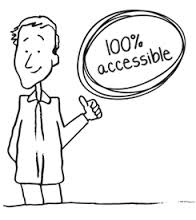 In our first installment of our 3-part series we looked at the importance of having an accessible eLearning. Today we want to focus how you can achieve accessibility for your learning management system (LMS) and educational content. This post, the second in a three-part series, will look at what you need to do, when creating e-learning content, to make sure that it is accessible to people of all abilities and disabilities.
In our first installment of our 3-part series we looked at the importance of having an accessible eLearning. Today we want to focus how you can achieve accessibility for your learning management system (LMS) and educational content. This post, the second in a three-part series, will look at what you need to do, when creating e-learning content, to make sure that it is accessible to people of all abilities and disabilities.
What your LMS will take care of for you
If you’re using an LMS built with accessibility in mind—like Moodle or Totara—the hard work has been done for you. Here’s what you can count on, out of the box:
- ‘Alt tag’ text descriptions required for all images.
- The ability to designate a student as the user of a screen reader, so that page content adapts to the read-out-loud format and that interfaces are simplified to remove clutter.
- Long lists of links can be skipped by the screen reader.
- Zoom-enabled, allowing users to increase the size of content for better readability.
- Keyboard navigation, important for users with mobility limitations.
What you need to do for accessible e-learning content
A good LMS will do the heavy-lifting to make e-learning accessible, but content must still be created, organized, and formatted by educators and training administrators with these three best practices in mind:
3. Present content in multiple ways
All non-text content should be paired with a text alternative. In practice, this means:
- ‘Alt tags’ for images written to clearly describe what the image depicts
- Videos with captions describing the audio track
- Audio with a text transcript
- Form inputs labeled
Videos and other visual multimedia content such as infographics, GIFs, and animations should be paired with a description. For example:
- A text description of the content, for screen readers
- An audio description
2. Organize, structure, and make content clear
It is important to know that how content is displayed on a web page does not necessarily represent how the content is organized and structured in the underlying markup—the HTML. Screen readers read the markup, not the page presented visually in the web browser.
While learning basic HTML is ideal (and not hard to do), using your LMS content editor’s formatting tools correctly will make better underlying markup, and a better experience for screen-reader users. Here’s how:
- Don’t just bold titles and headers—use the correct ‘styles’ to organize and identify different levels of headings: H1, H2, H3, H4.
- Don’t use hyphens or other characters to manually mark up lists—use the bulleted or numbered list styles.
- Don’t use tables to style content—but do use them if you are presenting an actual table of data.
- Don’t use colored or highlighted text to make passages stand out—use bold for importance, italic for emphasis, and blockquote for call-outs or quotes.
While HTML markup organizes and structures the content, visual styling does matter in making content clear and discernable for users with limited vision:
- Avoid using color on its own to distinguish or organize content, as color-blind users might have difficulty discerning differences.
- Ensure sufficient contrast—dark and light—between visual elements.
3. Make content and navigation consistent
All web users—of all abilities—face a learning curve when encountering a user interface for the first time. Ensuring consistency in how navigation and content are organized and displayed helps decrease the learning curve, and improves accessibility—for everyone. Creating a first-visit tour, a “welcome course”, or a tutorial that orientates new users to the primary navigation and tools used in your LMS will help all users start on the right path.
What can you do to put these accessibility principles into practice?
Training administrators and educators can ensure the accessibility of their e-learning content by following a series of steps that will elucidate where things are at currently and what actions should be taken.
What are those steps? Stay tuned—we’ll cover that in part #3.




